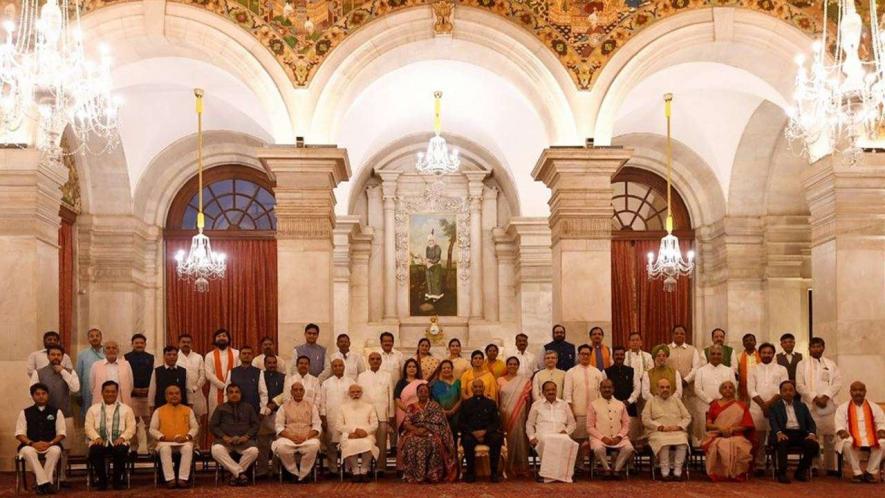New Ministers, New Decisions – Old Story

Image Courtesy: DNA India
On July 7, Prime Minister Narendra Modi reshuffled and expanded his Cabinet bringing in 43 new ministers and dropping 12 incumbents. There was euphoric wall-to-wall coverage in the mainstream media, helped along by well-planted ‘analyses’ from the ruling Bharatiya Janata Party itself extolling the caste combinations, the younger average age (down to 58 from 61 years) and the foresight with which PM Modi had inducted technocrats and dedicated professionals.
The next day, the new cabinet met and took a slew of decisions, again reported avidly by the media as a “fresh and energised” approach to looming issues that have dogged the Modi government’s steps for the past more than a year.
As far as the Cabinet reshuffle and the new faces goes, reams have been written about it. It appears to be a reassertion of the authority of PM Modi and his trusted lieutenant Amit Shah, who have drawn in persons from the Sangh Parivar mostly, and whose loyalty to them is unquestionable. The primary consideration has been the upcoming State Assembly elections early next year. That’s why the heavy presence of new ministers from Uttar Pradesh and Gujarat, and that’s why the caste calculus, unashamedly spelt out by the media at the presumed instance of some BJP insiders. Coming from a party that keeps talking about rising above caste divisions, this is rather rich, but then the BJP has never been shy of saying one thing and doing another.
But more than the obvious optics of the reshuffle, it is the decisions of the new Cabinet that reveal the government’s thinking. And, tragically for the country, these decisions only confirm that the government is not only continuing its repackaging and reselling policy but that there is no new thinking on three gigantic issues that are confronting the people. These are: the COVID-19 pandemic, the farmers’ protest movement and the sinking economy.
How to Handle the Pandemic
The new Cabinet, in its very first meeting, decided to spend Rs 23,212 crore on meeting the pandemic challenge. The second wave has not yet abated fully and most scientists have warned that a third wave is almost certain, which could be even deadlier than the second one. After the horrendous carnage and near-collapse of the healthcare systems that was seen in India in April-May this year, the Modi government had rightly come under heavy criticism for being unprepared and unable to take quick decisions. So, preparing now for future waves is the right thing, and certainly more spending is what is required.
Last year, Rs.15,000 crore was allocated and about Rs.6309.9 crore was given to state governments to strengthen their infrastructure, according to a reply by the government to question no.100 raised in Rajya Sabha on February 2, this year. About Rs.5,000 crore was spent on arranging ventilators, medical oxygen, testing kits etc. This was the status on January 21. Presumably, some more would have been spent – probably finishing off the Rs.15,000 crore allocated.
The new announcement of Rs.23,212 crore is not what it seems. It is made up of two components – the Central share, which is Rs.15,000 crore and the States’ share, which is the balance Rs.8,123 crore. So, actually the announcement is slightly misleading. It should have said Rs.15,000 crore. Which is the same as last year.
What will these two components be used for? The Central share will be spent on:
·Support to Central Hospitals, AIIMS, and other health ministry institutions for repurposing 6,688 beds for COVID management.
·Strengthening National Centre for Disease Control (NCDC), especially for genetic sequencing
·Setting up Hospital Management Information System (HMIS) in all District Hospitals (at present, this is implemented only in 310 DHs), to help in implementation of the National Digital Health Mission (NDHM).
·Support for expanding of eSanjeevani tele-consultation platform.
·Support strengthening the Central war room at the health ministry, strengthening COVID-19 portal, 1075 COVID helplines and COWIN platform.
So, the whole Rs.15,000 crore is going to the top echelons of the healthcare and medical science system. It is also pursuing the push for digitalisation of health records, which insurance companies need desperately, and for tele-consultations with doctors. Scientific research strengthening or making available 6,688 COVID-ready beds in central hospitals is fine. Information and data collection from district hospitals is also fine.
But is that all? The Central government can visualise its role only up to this much and no further in this unprecedented pandemic which has already affected over three crore Indians and killed over four lakh?
What the Modi government is doing is to continue creating the ground for installing a completely privatised, insurance-based healthcare model like the one in the US. As far as handling the nuts and bolts of the pandemic – the plan throws the ball squarely into the State government’s lap.
The second component of the new announcement is the State Government’s contribution of Rs.8,123 crore. This will be used for:
·Create paediatric units in all 736 districts.
·Augment 20,000 ICU beds in public healthcare system.
·Provide pre-fabricated structures for adding additional beds at the existing CHCs, PHCs and SHCs (6-20 bedded units) and bigger field hospitals (50-100 bedded units) at tier-II or Tier-III cities and district HQs.
·Install 1050 of Liquid Medical Oxygen Storage Tanks with Medical Gas Pipeline System (MGPS), at least one such unit per district.
·Add 8,800 ambulances.
·Engage medical/nursing students and interns for effective COVID management.
·States to maintain at least 21.5 lakhs tests per day.
·Essential medicines for COVID-19 management, including creation of buffer stock.
So, there you have it. The real battle against COVID-19 has to be carried out by state governments from their own pockets. While claiming all this as a Central Government package, in reality, the Centre has washed its hands off the real battle and asked the states to pony up for doing all this.
This is a continuation of last year’s strategy of shifting the whole responsibility on to the cash-strapped State governments while providing them with nothing. The money too is to be raised by them. With this as the great fresh decision of the dynamic new Cabinet, it’s not difficult to imagine what is going to happen in the coming months.
Agriculture Infrastructure – Preparing for Corporatisation
The other ‘major’ decision of the new Cabinet is even more fraught. It says that the Rs.1 lakh crore Agriculture Infrastructure Fund (AIF) can now be used for strengthening the Agricultural Produce Marketing Committee (APMC) infrastructure. Various exemptions and interest subventions are listed out for that purpose. This is portrayed as some kind of reassurance to the protesting farmers that APMCs are there to stay and that their fears and anger is uncalled for.
First, it is not a new decision. While presenting the Budget for 2021-22 in February this year, Finance Minister Nirmala Sitharaman had announced the same thing. It has been slightly fleshed out and re-announced again by the new Cabinet.
Second, the use of AIF for strengthening the APMCs in no way addresses the fears and worries of the farmers, which arise from the three new agriculture related laws. Their concern is that the new laws spell out the privatisation of trade in agricultural produce, reduce government procurement, refuse to ensure Minimum Support prices and thereby render the whole present system of APMCs and some financial support to farmers redundant. This in turn eases the way for corporate takeover of trade, storage and ultimately pricing control too, taking all the laws together.
Third, by merely giving APMCs better infrastructure, and not removing the threat of corporate takeover, the Modi government is actually facilitating the entry of corporates by sweetening the deal for them. They will have readymade infrastructure – modern APMCs, cold chains, sorting and grading units, silos, warehouses – available and can hit the ground running, as they are fond of saying.
Far from being a move toward reconciliation with the protesting farmers, it is a cleverly concealed assertion that the Modi government is not going to back down. The farmers movement has not taken kindly to this move, having seen through the design straightaway. After seven months of protests, the movement is flexing its muscles again and the coming months will see a further intensification. This is how the new ‘dynamic’ Cabinet has started its innings.
As far as the economy itself is concerned, the new Cabinet’s indifference can only be matched by the paralysis of the preceding Cabinet. No fresh thinking appears to have taken place at the top, even as unemployment continues at high levels, investment is a bare trickle, bank credit is only inching up, wages and earnings are stagnant and a large portion of the productive economy is still laid low. Once the third wave hits, things will become worse.
But the country is still – sadly – going to be led by indifferent men and women, even if they are new to the job and full of youthful zeal.
Get the latest reports & analysis with people's perspective on Protests, movements & deep analytical videos, discussions of the current affairs in your Telegram app. Subscribe to NewsClick's Telegram channel & get Real-Time updates on stories, as they get published on our website.
























